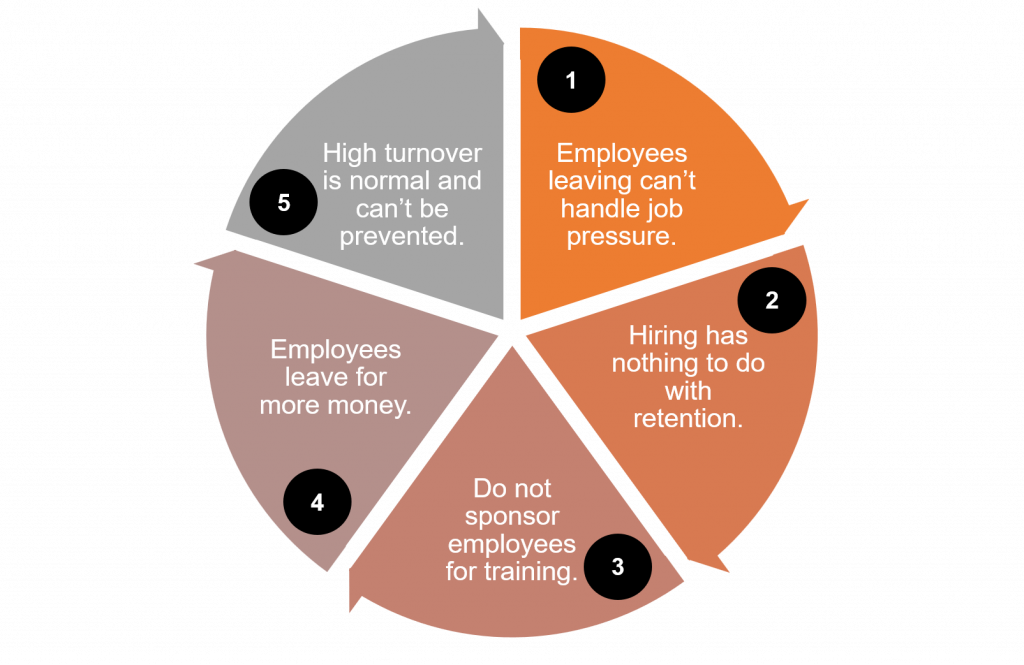Employee Retention
Retaining good employees is a challenge for all organizations. While most organizations say they want their employees to stay, employee turnover is considered an acceptable part of doing business. Very few organizations try to keep their retention numbers high. Many organizations tend to fall prey to popular myths around employee retention.
The 2021 Bureau of Labor Statistics Report states that the overall turnover rate is 57.3%. Industries like retail and food services are considered to have high turnover rates. It has been as high as 65% for retail and 73% for food services in the past few years. Companies have come to terms with accepting these numbers. On top of that, there are many myths around retaining employees, which further weakens the need to retain talent.
Take a look at these 5 popular employee retention myths:

Myth #1: Employees leave because they cannot handle the job pressure.
Organizations that go through many changes tend to believe that most of their employees leave only because they cannot handle the pressure. This perception is rarely the true. Pressure can be a contributing factor in some cases. However, in many cases, reasons like confusing work structure, inadequate feedback, poor leadership, lack of recognition, and poor culture play a significant part in losing good talent. Often, employees leave when their needs are not met. In more prominent organizations, employees leave because they do not have adequate responsibilities and ownership. They prefer not to waste their talent and look for employers to be challenged and rewarded.
Myth #2: Hiring has little to do with retention.
This belief is entirely untrue. It is quite the opposite. Effective recruitment is the first step to talent retention. Employees evaluate their companies from the time they start the application process. Candidate experience is one of the biggest reasons talented candidates choose not to accept the offer. Fit plays a vital role in the success of an employee. Candidates trust the recruiter to evaluate their fitment in the team as they have limited exposure to the organization at that juncture. An efficient recruitment process is an excellent start to retaining an employee. It shows the organization’s commitment to hiring good talent. Having an intelligent Applicant Tracking System is another plus. A great onboarding program will reinforce their choice and help with retention.
Myth #3: If you sponsor employees for training, you train them for another employer.
Many organizations deprioritize talent development over other priorities. As a result, employees often look for various growth opportunities. After all, no one wants to stay in the same role for years. When sponsored for external training programs and certifications, employees tend to feel motivated and often grow. Offering good training and development will increase job satisfaction, gain new skills, and help employees become experts in their current roles. 360 Degree Feedback is a great way to start the development process.
Myth #4: Employees mostly leave for more money.
This thought is a popular myth. More money is tempting to anyone, but employees rarely leave ‘just’ for money. When employees are satisfied with their job, they will rarely look for opportunities outside. Career development opportunities increase employee motivation and productivity. If they get career development opportunities, they would rather stay with their company and grow than go to a new organization and establish their credibility from scratch. A good reward and recognition strategy is a great way to retain employees. Providing excellent wellness benefits is another perfect way of retaining employees.
Myth #5: High turnover is normal and cannot be prevented.
Employee turnover may seem like a normal thing in all companies, especially in the last couple of years when the demand for candidates has gone up exponentially. However, high turnover should never be overlooked. For example, your turnover report may have a higher number after summer when the summer co-op students leave. But any other time, high turnover has underlying reasons.
Consider benchmarking your turnover rates with the industry peers. Review the exit interview notes and check for trends. Continue to review the turnover number month on month along with yearly trends. Check the percentage of employees applying for disability leave and those returning to work on time. Look for root causes of the trends observed. For example, identify teams that have less staff and are overworked.
In conclusion, every organization will have its myths on employee retention. Debunk them by looking at them objectively with data.
Related Resource: Best Hiring Practices – Top Questions Answered
Related Blog Post: Why Managing With Empathy Increases Employee Engagement


 Dr. Jaffee (M.A., Ph.D.) is a recognized expert in the field of assessments, and has created effective HR Solutions used by millions of people.
Dr. Jaffee (M.A., Ph.D.) is a recognized expert in the field of assessments, and has created effective HR Solutions used by millions of people.